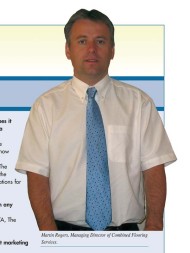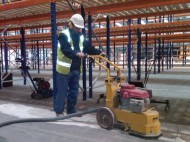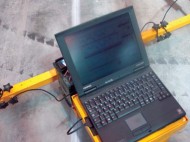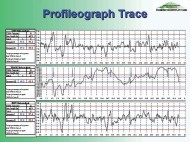 The last two years have seen some exciting business developments for Combined Flooring Services, the flooring flatness experts. CFS originally set up as a specialist in flooring flatness, offering consultancy, surveying and flatness implementation to the industrial marketplace. In the construction sector it continues to carry out surveys to ensure floors achieve superflatness and train contractors’ staff to attain superflat floors. But during the recession, CFS’ other major marketplace, the warehousing and logistics industry, has seen a sea change, literally at floor level.
The last two years have seen some exciting business developments for Combined Flooring Services, the flooring flatness experts. CFS originally set up as a specialist in flooring flatness, offering consultancy, surveying and flatness implementation to the industrial marketplace. In the construction sector it continues to carry out surveys to ensure floors achieve superflatness and train contractors’ staff to attain superflat floors. But during the recession, CFS’ other major marketplace, the warehousing and logistics industry, has seen a sea change, literally at floor level.
Fewer new warehouses are being built, and existing warehousing operations are working more intensely, squeezing the maximum out of their existing space. This has sharpened the focus on VNA (Very Narrow Aisle) working and on repairing and refurbishing existing warehouses, starting with the floor. It’s taken Combined Flooring Services into some major new areas – wire guidance installation and troubleshooting, high tolerance floor grinding, Very Narrow Aisle floor consultancy services and crucially, floor repairs. Martin Rogers, Managing Director of Combined Flooring Services, spoke to Warehouse & Logistics News.
Warehouse & Logistics News – First of all, Martin, for the uninitiated, can we start by defining what ‘superflat’ means, and how superflat floors compare with ‘normal’ warehouse floors?
Superflat is a term that has been bandied around for many years. Technically the term Superflat only applies to floors used for narrow aisle racking systems. Furthermore it is only the floor within the trucking aisle wheel tracks that can be specified as superflat. The Superflat specification cannot be specified for any other type of floor. When comparing normal and superflat floors, the difference is that a superflat floor will be more than twice as flat as a standard free movement floor.
WLN – Where are the standards for floors set down?
 We are currently in a phase where a number of very different floor standards are being specified in the UK. The Concrete Society technical report 34 (TR34) 2003 is the one most commonly used in the UK, however it is anticipated that a new edition of TR34 will be published this year. The flatness specification in the proposed new TR34 document is very different from that currently used for the last 20 years. In addition we have a new Euro standard, which was published late last year, and are likely to get a guidance document from the federal European manufacturers. We always advise clients that the best advice comes from the materials handling suppliers themselves, as they have to guarantee the system.
We are currently in a phase where a number of very different floor standards are being specified in the UK. The Concrete Society technical report 34 (TR34) 2003 is the one most commonly used in the UK, however it is anticipated that a new edition of TR34 will be published this year. The flatness specification in the proposed new TR34 document is very different from that currently used for the last 20 years. In addition we have a new Euro standard, which was published late last year, and are likely to get a guidance document from the federal European manufacturers. We always advise clients that the best advice comes from the materials handling suppliers themselves, as they have to guarantee the system.
WLN – What do you define as VNA? How much flatter must floors be in Narrow Aisle and VNA environments?
VNA (Very Narrow Aisles) is defined as aisles where trucks run in a fixed path with minimal clearance, typically 80-150 mm, rail- or wire-guided. Floors clearly need to be much flatter in VNA due to the lack of clearance as opposed to that in a normal wide aisle reach truck environment.
WLN – Are you involved in setting these standards?
I have been involved in writing floor flatness standards for nearly 30 years, but I have taken a step back on this latest publication.
WLN – Where and when was Combined Flooring Services set up?
Combined Flooring Services was established in Southampton in 1988.
WLN – How involved are you these days in individual client projects?
I have always adopted a hands-on approach in terms of client contact, since Combined Flooring Services was formed. I endeavour to visit a good proportion of projects myself, either pre- or post-work. I am fortunate to have a good team of engineers behind me to support me, should I not be able to make a site visit myself.
WLN – We last spoke nearly three years ago. What proportion of your business now involves warehouses? How does this compare with before?
It was indeed some time ago that we last spoke. More than 90% of our work involves warehouse-related projects, and most of our work is VNA-related. I don’t think this proportion has changed dramatically since then. However, new build has slowed in recent times, so our surveys on new projects have been impacted. However I hope 2010 will be a better year for our clients constructing floors.
WLN – What proportion of your warehouse work is VNA? Again, how has this changed in the last few years?
We have not significantly diversified outside the VNA floor area.
Rather than significantly change direction and move to the arena of general floors, we prefer to improve and research on methods to continually improve on the services we currently offer. In the last two years, we have added wire guidance installation to our services for VNA and brought in additional specialised survey equipment.
WLN – The forklift truck companies are often the prime movers in changing a warehouse over to VNA working. How closely do you work with them to make the necessary changes to the floor and install wire guidance systems?
We work very closely with the forklift companies, as we understand they have to provide a solution to a client who may need some guidance on the suitability of a floor. In working together on client issues, we have built sound relationships with the forklift companies, giving them the confidence to provide long-term client support. A good working relationship is the key to both our and the forklift manufacturers’ future success in improving our VNA services.
WLN – Do you still have the Profileograph forklift truck movement simulator? How is it used?
 Yes, we still have the Profileograph, and have also developed other measuring machines based on its model. Our Profileograph gives us real-time on screen information. We use the machine to check compliance to VNA specifications and for assessment of a floor’s suitability for VNA installations.
Yes, we still have the Profileograph, and have also developed other measuring machines based on its model. Our Profileograph gives us real-time on screen information. We use the machine to check compliance to VNA specifications and for assessment of a floor’s suitability for VNA installations.
WLN – How do you measure floors to ensure your grinding meets the agreed standard?
There are two stages to consider. Firstly we ensure the areas that have been ground comply with the agreed tolerances by using the Profileograph to resurvey the work carried out. Stage 2 is to run the truck in the aisles to further ensure the truck is able to meet the client’s expectations. Our guarantee is to monitor the truck performance during the installation and address any areas of the floor that may need further enhancement.
WLN – What floor grinding techniques are involved in working in warehouses?
Floor grinding is very specialised. Essentially there are two techniques. Large machine grinding is one technique that generally lowers the profile of the whole aisle or tracks in order to attain the chosen standard of flatness. Our system is more hands on skills based, and requires more precise marking and localised grinding. We only treat the areas that need grinding, thus making it more floor friendly, as the damage caused by heavy machine grinding is sometimes concerning.
WLN – Do you carry out all this work yourselves?
We do not contract work out, as there is no one else in the world with the experience and ability to do what we do. Contracting out is appropriate for some trades, but certainly not ours.
WLN – What other services do you offer in connection with VNA?
 If there are VNA and floor-related problems, we can normally provide advice or offer solutions. Trucks coming offline are a thing of the past with us. For certain problems we would operate on a no fix, no fee basis, which gives the client the assurance that he will get the problem fixed. We have introduced straight-cut services in the last two years.
If there are VNA and floor-related problems, we can normally provide advice or offer solutions. Trucks coming offline are a thing of the past with us. For certain problems we would operate on a no fix, no fee basis, which gives the client the assurance that he will get the problem fixed. We have introduced straight-cut services in the last two years.
WLN – Is Straight-cut a system that you’ve developed yourselves? How does Straight-cut work?
Straight-cut is a machine that we have developed over the past two years. Unlike conventional floor saws that rely on an operator’s good eyesight, straight-cut has an on-board computer and camera that allow the saw operator to track along a perfectly straight line. This means that the straightness of the wire guidance system is more assured. The straight-cut machine is also self-propelled, which means less effort for the operator, allowing him to focus on the straightness.
WLN – Is there a standard cost for upgrading a floor to VNA tolerances?
It’s a question we often get asked, but the answer is not that simple. The reality is that we first survey the floor and then discuss the results with the client and truck supplier. Based on the outcome, we will come up with a solution and a cost for making the project work. For example, an end user with racking 13m high and 20m long aisles may not need a superflat floor if the throughput is slow. Conversely an end user with aisles 100m long needing to run trucks at high speeds may need a superflat floor, but cost could be vastly different.
WLN – What is the process to upgrade an existing floor for VNA working? What’s the difference in price between refurbishing a floor for VNA work and putting in a totally new one?
The process to upgrade is dependent on the work required. Generally floors in the UK have been cast to a good standard, so upgrading is normally undertaken by localised grinding. When the floor is less flat and the client requires superflat tolerances, a floor screed or new floor may be required. Localised grinding is almost always more cost-effective.
WLN – How do your consultancy services work?
When Combined Flooring Services was formed in 1988, a significant part of our business was consultancy working with flooring contractors, engineers and end users to help them understand the importance of flat floors. We also offered surveying and monitoring of floor construction, a service we have carried out frequently over the years. As the markets have developed and matured, many of our construction clients are now aware of the requirements for floor construction and tolerances, therefore the need for such services has declined.
WLN – How do you present your proposals?
Once a survey has been completed we compile the data in a full report showing the condition of the floor. Our proposals are then presented to the client, and the various options available are detailed in the report.
WLN – What external factors do you see affecting demand for your services?
Clearly we are still in a downturn, and the demand for new floors has diminished. We currently see many warehouse owners trying to squeeze the maximum storage into their buildings, thus the need for higher racking and better floors is apparent.
WLN – Clearly you have been very successful. Is it all down to you personally?
 We have been extremely lucky to have some great clients, who have been loyal to us for many years. Many clients have been using us for more than 10 years, and some have been since the business started in 1988. These are the people that have made us successful. In addition our engineers and staff are self-motivated and keen to attain the goals that will make a project successful. So in summary no, our success is not all down to me, it is also due to all those involved with Combined Flooring, both clients and staff, and it will continue to be so for the foreseeable future as we help our clients and partners arrive at the best possible solution for their flooring problems.
We have been extremely lucky to have some great clients, who have been loyal to us for many years. Many clients have been using us for more than 10 years, and some have been since the business started in 1988. These are the people that have made us successful. In addition our engineers and staff are self-motivated and keen to attain the goals that will make a project successful. So in summary no, our success is not all down to me, it is also due to all those involved with Combined Flooring, both clients and staff, and it will continue to be so for the foreseeable future as we help our clients and partners arrive at the best possible solution for their flooring problems.
Combined Flooring Services Ltd Tel: 02380 262017 www.combinedflooring.co.uk




Comments are closed.